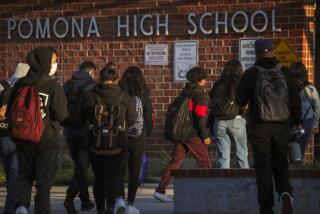United Way to Give Donors a Choice
- Share via
NEWPORT BEACH — United Way of Orange County will join a handful of other chapters around the country in allowing donors unlimited choice in where their contributions are spent during the upcoming fund-raising campaign, officials said Wednesday.
At a press conference announcing the 1990 goal of $22.5 million, officials said donors will now be able to target their contributions not only to specific agencies but also to specific issues, such as child care, drug abuse or homelessness.
“United Way has listened to its donors, and this process is a response that will offer them an opportunity to become more involved in their community,” said 1990 campaign chairman David Holman, an executive vice president of First Interstate Bank.
Added Harry Taylor, vice president for fund distribution: “This positions the United Way method of giving as the best choice for charitable dollars.”
Many charity specialists say such donor-directed programs will probably be the wave of the future as employees, traditionally the United Way’s primary contributors, seek to exert more control over the use of their money.
Many also say candidly that local United Way chapters are being forced to make drastic changes in operations to stave off competition from alternative funds and criticism that United Way has not adequately addressed the needs of minorities or less well-established causes.
“We are constantly seeking to broaden the diversity of organizations we support,” acknowledged local United Way spokesman Jeff Rocke. “Traditional organizations that are well-established serve a greater number of people and perhaps have a more plentiful mix of programs that warrant support. But one purpose of the change is to become more inclusive.”
The Orange County effort is part of a pilot program being undertaken in 10 communities for the upcoming fund-raising campaign.
Donors will have three broad categories in which to give:
* Community Care. Traditionally, 90% of contributions have gone into this category, which funds 118 United Way member organizations ranging from the Girl Scout Council of Orange County to the American Cancer Society. This category gives United Way officials the most leeway in directing funds to community needs that they have identified as most pressing.
* Specific Care. Donors may specify any legitimate nonprofit organization for their contributions, including ones that are not members of United Way or even in Orange County.
* Targeted Issue Care. Donors can identify one of seven issues--literacy, substance abuse, health care for the needy, child care, mental health, homelessness and physical or sexual abuse--for their contributions. Funds in this category will be awarded on a competitive basis to any nonprofit organization.
Local officials say the changes were made because results of surveys and focus groups have indicated that people are more motivated to give when presented greater options.
However, successful experiments with donor choice in such cities as Seattle and Philadelphia may prove less meaningful in Orange County, where county-based corporations have traditionally contributed far less per capita than comparable urban areas.
In fact, last year’s campaign, which amassed a record-setting $20.6 million, ended four consecutive years in which the local agency failed to meet its fund-raising goal.
“There has been evidence that is has enhanced the (fund-raising) campaign, but there’s no evidence it is going to turn us around,” Rocke said. “It is something that builds over time, and it also sustains the givers we currently have.”
Rocke conceded that some member agencies have expressed concern that expanding participation so radically will mean fewer dollars for their own programs.
But donor-choice proponents argue that greater choice means more money for everyone.
“We are very optimistic,” said Marilyn Ditty, executive director of San Clemente Seniors, one of only four United Way agencies that serve senior citizens. “There is an increasing emphasis on the needs of seniors, and though we are a very small agency, I am hopeful we will be able to get more funds designated for us.”
Officials with other United Way member agencies agreed. “We are not sure we have a handle on what the impact will be for us, but we think it will mean an increase in the amount of money and the numbers of donors,” said Warren Johnson, business manager for the local Salvation Army branch. Johnson said 23% of the group’s budget comes from United Way.
“One concern, though, is that the United Way family will get so big that we are duplicating services that already exist,” Johnson added.
Indeed, concern has also been expressed that the donor choice program cedes too much power from United Way officials to direct funds, relegating the agency to a collection and distribution outfit.
“It is not a flawless system; we are going to require some refinements, and we are going to have to make some judgments along the way,” Rocke said. “But I believe it is the most responsive and flexible system that has been developed in the country.”
The 1990 campaign will begin Sept. 8 with a sandcastle contest at Seal Beach. The campaign will end Jan. 23.
More to Read
Sign up for Essential California
The most important California stories and recommendations in your inbox every morning.
You may occasionally receive promotional content from the Los Angeles Times.














